Inside four bustling rooms at USF Health Center for Advanced Medical Learning and Simulation (CAMLS), emergency medicine residents from USF Health, emergency nurses from Tampa General Hospital, and paramedics from Tampa Fire and Rescue worked together in simulation exercises to improve how they work as a team during intense emergency situations. Over the course of the day, the residents rotated through four scenarios: a patient with undifferentiated chest pain, a 5-year-old with complications from a snakebite, an infant with an unstable abnormal heartbeat, and a patient in cardiac arrest.
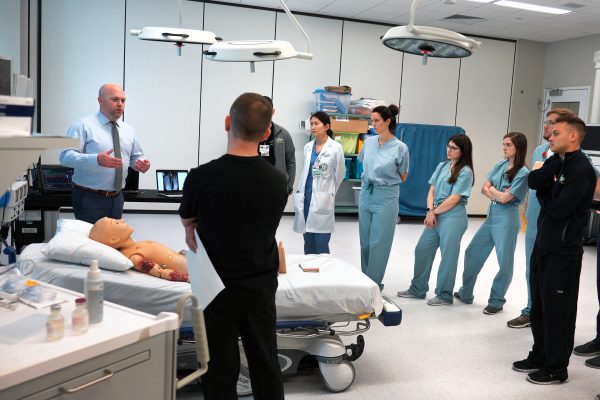
Ryan McKenna, DO, director of the interprofessional simulation fellowship at USF Health CAMLS and director of simulation for Emergency Medicine, guides participants through the snakebite simulation.

A team of emergency medicine residents from USF Health work together to help a manikin with undifferentiated chest pain.
The interprofessional team involved in the cardiac arrest simulation, practiced the process and communication of the transition from the pre-hospital team to the emergency department. This scenario was intentionally cut short after the first five minutes as a part of its educational design, also called scaffolding, said Ryan McKenna, DO, director of the interprofessional simulation fellowship at USF Health CAMLS and director of simulation for Emergency Medicine. The goal of this kind of teaching method is to make the information more manageable to retain by breaking up the lesson into segments. Not only does scaffolding avoid students becoming overloaded, but it also allows learners to identify subtle ways to improve that might be missed in a larger scenario.
“When you have focused efforts, you have a chunk of a component of that training that can now be brought into clinical practice and everyone has the same mental model and is applying it in the same way,” said Yasuharu “Haru” Okuda, MD, FACEP, FSSH, executive director of CAMLS and executive director of interprofessional education simulation programming for USF Health.
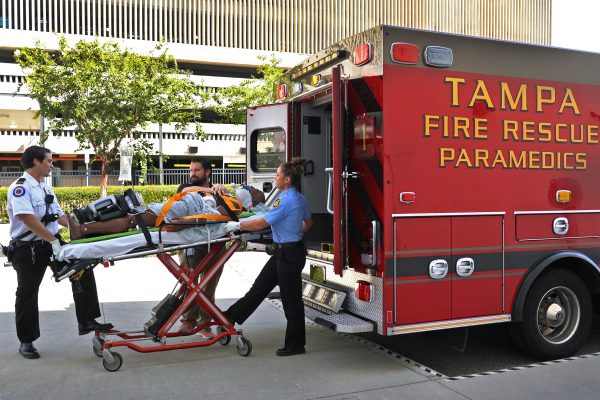
Paramedics from Tampa Fire and Rescue helped to bring the cardiac arrest simulation to life.
During one of the run-throughs of the cardiac arrest simulation, an observing resident noticed that the nurse performing chest compressions on the manikin might benefit from standing on a nearby stool to improve her ability to perform compressions. He brought it over to her and placed it by her feet, but the message about the height-assistance was lost in the chaotic sounds of the emergency department and she did not notice the stool was there until the end of the simulation. That is just a simple example of the kind of communication gaps that can result in a missed opportunity or medical error in a hospital and it’s a small area for improvement that would have been missed in a more complex simulation. Many of the residents reported back to Dr. McKenna that they were already using the skills they learned to improve the hand-off in the subsequent days following the simulation-based training.
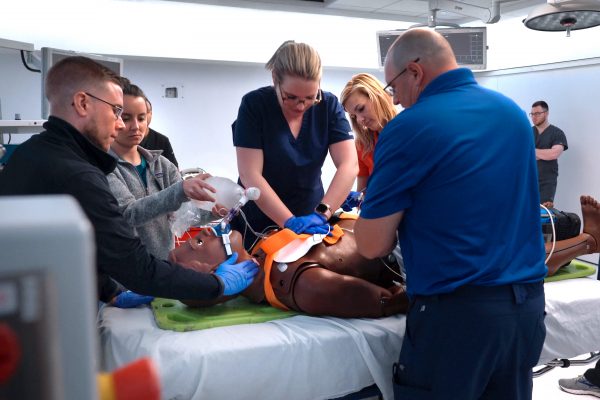
An interprofessional team including emergency medicine residents from USF Health, emergency nurses from Tampa General Hospital, and paramedics from Tampa Fire and Rescue, came together for simulation-based training.
In November 1999, the Quality of Health Care in America Committee of the Institute of Medicine (IOM) released a report called To Err is Human: Building a Safer Health System that stated as many as 98,000 hospital deaths occur each year due to medical error. Communication error is described as the cause of 60% to 70% of those preventable hospital deaths.
“We’ve done a lot of amazing things in technology and medical knowledge and science, but I think one thing that we haven’t done well enough in health care is really learning to work together in teams,” Dr. Okuda said.
Twenty years after the IOM’s report, the statistics are still alarming. In an effort to make life better and combat medical errors, USF Health incorporates interprofessional education as a primary part of its curriculum.
“Especially in the ER, it’s a team discipline,” said Kelsey Hundley, MD, second-year emergency medicine resident with the USF Health Morsani College of Medicine. “Learning how to interact with people with different backgrounds and roles on the team is really important.”

Kelsey Hundley, MD, second-year emergency medicine resident with the USF Health Morsani College of Medicine, works with her team to help the infant with an unstable abnormal heartbeat.
Simulation exercises as a part of interprofessional education allows participants to practice in a realistic but safe environment, both for the learners and for the patients.
“It was a pretty enjoyable experience,” said Adam Koby, MD, second-year emergency medicine resident with the USF Health Morsani College of Medicine. “We see these scenarios all the time in real life, but there’s always the opportunity to improve and I feel the way that you would improve the most is to practice those situations. During these simulations, we learn about individual pathologies, but more importantly, about team building.”
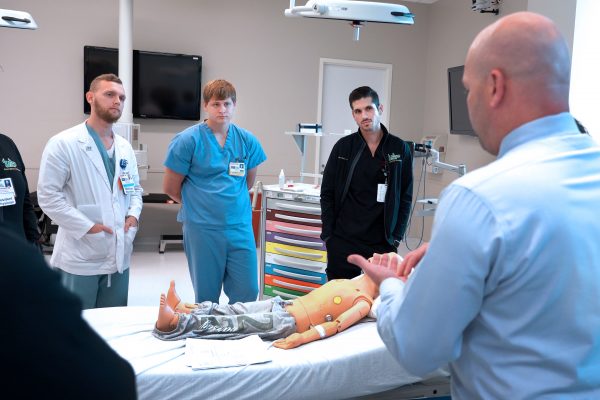
Adam Koby, MD, second-year emergency medicine resident with the USF Health Morsani College of Medicine (right), listens to Dr. McKenna during the debrief of the snakebite simulation.
When the various medical professions came together and were working in a training environment, “I saw smiles, energy and enthusiasm and I’ll bet you, for many of these folks, they won’t forget this,” Dr. Okuda said. “They shared the passion and I think coming together outside the clinical environment often builds stronger teams. So beyond just the training, there are the personal connections and the bonds that were created through this environment and interaction.”
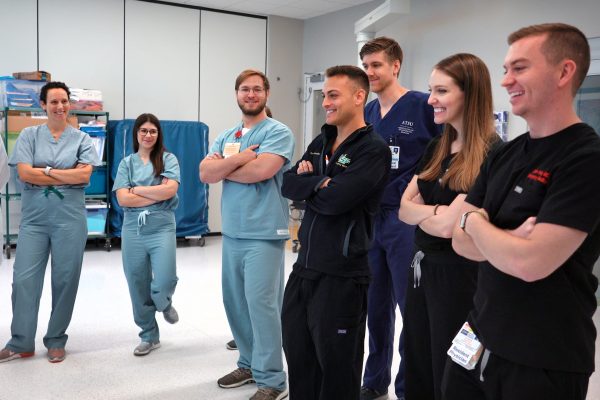
Participants shared laughs and smiles during the simulation-based training held at the USF Health Center for Advanced Medical Learning and Simulation.
